
Journal of Food and Agriculture Research
Frequency :Bi-Annual
ISSN :2583-1291
Peer Reviewed Journal
Isolation and Quantification of Cellulose from Various Food Grade Macroalgal Species and its Characterization using ATR-FTIR Spectroscopy
Janani Muthukumar & Ramalingam Chidambaram. 2022. Isolation and Quantification of Cellulose from Various Food Grade Macroalgal Species and its Characterization using ATR-FTIR Spectroscopy. Journal of Food and Agriculture Research, 2: 1, pp. 1-18. https://doi.org/10.47509/JFAR.2022.v02i01.01
Utilization of Defatted Rice Bran for the Development of High Fiber Bread
Neelam Yadav, Devinder Kaur, Pinki Saini, Nidhi Tiwari & Monika Singh. 2022. Utilization of Defatted Rice Bran for the Development of High Fiber Bread. Journal of Food and Agriculture Research, 2: 1, pp. 19-32. https://doi.org/10.47509/JFAR.2022.v02i01.02
Development of Green Chili Sauce Modulated by Pea Pod Powder as a Functional Ingredient
Rajeev Ranjan, Shubhendra Singh, Radha Yadav & Anil Kumar Chauhan. 2022. Development of Green Chili Sauce Modulated by pea pod Powder as a Functional Ingredient. Journal of Food and Agriculture Research, 2: 1, pp. 33-44. https://doi.org/10.47509/JFAR.2022.v02i01.03
Recent Developments in Plant Breeding from the View of Animal Nutrition
Gerhard Flachowsky. 2022. Recent Developments in Plant Breeding from the View of Animal Nutrition. Journal of Food and Agriculture Research, 2: 1, pp. 45-57. https://doi.org/10.47509/JFAR.2022.v02i01.04
Farming Practices, Knowledge, and Constraints in Apple Production in Ladakh: A Survey
Tsetan Dolker, Anand K Katiyar, OP Chaurasia & Tsering Stobdan. 2022. Farming Practices, Knowledge, and Constraints in Apple Production in Ladakh: A Survey. Journal of Food and Agriculture Research, 2: 1, pp. 59-69. https://doi.org/10.47509/JFAR.2022.v02i01.05
Short Communication: Use of De-topping as a Management Tool for Higher Productivity in Cotton
Ashok S. Jadhav. 2022. Use of De-topping as a Management Tool for Higher Productivity in Cotton. Journal of Food and Agriculture Research, 2: 1, pp. 71-76. https://doi.org/10.47509/JFAR.2022.v02i01.06